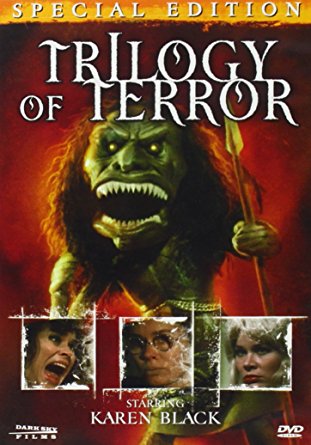 A classic made-for-TV three-parter that’s best remembered for its concluding segment, in which actress Karen Black is menaced by an evil doll. Of the other two episodes I tend not to hear much, and there’s a good reason for that.
A classic made-for-TV three-parter that’s best remembered for its concluding segment, in which actress Karen Black is menaced by an evil doll. Of the other two episodes I tend not to hear much, and there’s a good reason for that.
TRILOGY OF TERROR was initially broadcast on ABC back in 1974. The source material was three stories by the great Richard Matheson: “The Likeness of Julie”, which became “Julie”; “Therese”, a two-page sketch that became “Millicent and Therese”; and “Prey”, which became the immortal “Amelia”. Matheson himself adapted “Prey”, rightly deeming it the most powerful of the three tales, and gave his friend and fellow fiction scribe William F. Nolan the unenviable job of scripting the other two parts.
The producer/director was the late Dan Curtis, who’d already shown an affinity for horror as executive producer of the legendary DARK SHADOWS TV series and director of feature films like BURNT OFFERINGS (1976; scripted by TRILOGY OF TERROR’S William F. Nolan) and DEAD OF NIGHT (1977). For TRILOGY he procured the services of Karen Black, who was already an established feature film star (in DRIVE, HE SAID and AIRPORT 1975) and multi-Golden Globe winner (for FIVE EASY PIECES and THE GREAT GATSBY).
“Julie”: A horny college student finds himself strangely attracted to his frumpy English professor Julie. He convinces her to accompany him to a drive-in movie and there drugs her. Later he takes her back to his house, lays her out on his bed in various compromising positions and takes pictures of her, which he later uses to blackmail Julie into grating sexual favors. But the joke’s really on him, as Julie is not the shy, virginal woman she seems but a sexually aggressive murderess who has carefully orchestrated the seduction from the start…and now, it seems, she’s ready to move on, by killing the guy and seducing another.
“Millicent and Therese”: An aging psychologist becomes torn between the repressed Millicent and the sexually uninhibited Therese, both of whom detest one another. As their rivalry stretches on each becomes obsessed with killing the other. Millicent is the one who finally takes the plunge, creating a voodoo doll of Therese that she stabs in the torso. Yet the next day Millicent is found dead, the victim of an apparent heart attack—it seems she suffered from a severe case of multiple personality disorder, and so in killing Therese also did away with herself.
“Amelia”: The last and best episode finds a quiet young woman named Amelia dealing with her controlling mother, who always insists on phoning her late at night. Tonight, a Friday, is no different, with Amelia fielding an angry call from her mom. She’s thus forced to cancel a date with her boyfriend, who she’d planned on giving a Zuni Fetish doll she purchased earlier. The doll is an impressive specimen, complete with instructions warning of a warrior’s soul trapped inside that will spring to life if the chain is removed from its neck. Guess what? The doll is inadvertently knocked over and the chain falls to the ground…and the thing comes to life! What follows is an all-out fight to the death between Amelia and the doll, during which the lines between aggressor and victim become hopelessly blurred.
As I’ve already mentioned, it’s the last part of this film, “Amelia”, which makes it so effective. Regarding “Julie” and “Millicent and Therese”, there’s not much worth discussing. They’re not particularly shocking or surprising, and time has been kind to neither; I’d be surprised if anyone our there couldn’t guess the “twist” endings, as both are immediately obvious. (It is fun, though, seeing a young Karen Black slinking around in revealing outfits, as she does in “Millicent and Therese”.)
It’s the “Amelia” segment that everyone remembers, and which provides the cover art for all of TRILOGY OF TERROR’S home video incarnations (including the latest, Dark Sky Films’ 2006 special edition DVD). Director Dan Curtis was quite inspired for this one: the visuals really stand out (Curtis’ trademark low angle camera set-ups work wonders here), as does the surprisingly innovative use of sound: in the early scenes Curtis manages to subtly unnerve through the unexpected use of silence. The living, fighting doll that attacks the heroine makes for an unforgettable sight (it has a giant mouth and long, pointy teeth) and Black’s committed performance goes a long way toward making an outlandish tale into a horrifically convincing smack-down. Note the way the doll-Black confrontation grows increasingly brutal, and how Black becomes ever more animalistic in fighting off her tiny attacker.
I know many of you were scarred for life after viewing “Amelia” on TV back in 1975. I missed out on that experience, as it premiered a little before my time, but viewing it all these years later I completely understand what all the shouting was about.
Vital Statistics
TRILOGY OF TERROR
American Broadcasting Companies, Inc.
Director: Dan Curtis
Producer: Dan Curtis
Screenplay: William F. Nolan, Richard Matheson
(Based on stories by Richard Matheson)
Cinematography: Paul Lohmann
Editing: Les Green
Cast: Karen Black, Robert Burton, John Karlen, George Gaynes, Jim Storm, Gregory Harrison, Kathryn Reynolds
